Herpestes
Herpestes is a genus within the mongoose family Herpestidae. It is the type genus of the family and comprises ten living species, with several subspecies.[1] Fossil remains of three prehistoric species were excavated in France and described in 1853.[2]
| Herpestes Temporal range: Oligocene to present | |
|---|---|
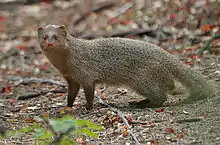 | |
| Indian grey mongoose (Herpestes edwardsii) | |
| Scientific classification | |
| Kingdom: | Animalia |
| Phylum: | Chordata |
| Class: | Mammalia |
| Order: | Carnivora |
| Suborder: | Feliformia |
| Family: | Herpestidae |
| Subfamily: | Herpestinae |
| Genus: | Herpestes Illiger, 1811 |
| Species | |
|
see table and range map | |
 | |
Native distribution of Herpestes species
| |
Characteristics
Males of the living Herpestes species have one chromosome less than females, as one Y chromosome is translocated to an autosome.[3] They are sexually dimorphic, with females smaller than males. They range in weight from 0.6 to 3.6 kg (1.3 to 7.9 lb).[4] They have several characteristics in common, including the shape of the cheek teeth and of the tympanic bullae, and the presence of the first upper molar teeth. They are all solitary.[5]
Classification
The scientific name Herpestes was proposed by Johann Karl Wilhelm Illiger in 1811 for mongoose species in the south of the Old World, commonly called 'Ichneumon' at the time.[6] Until 1835, 12 mongoose species from Africa and Asia were classified as belonging to the genus Herpestes.[7] In 1864, John Edward Gray listed 22 Herpestes species, which he considered as part of the Viverridae.[8] In 1882, Oldfield Thomas reviewed African mongoose zoological specimens in natural history museums. He subordinated those into the genus Herpestes that have nearly naked soles, four premolars, small last lower molars with two external cusps and whose last upper molars are 40-60% smaller than the last upper premolars. His list comprised eight species in Africa.[9] St. George Jackson Mivart listed 21 Herpestes species, including seven in Africa and 13 in Asia. He also determined Herpestes species by the dentition of mongoose specimens. His criteria included small premolars, small inner cusps of the third upper premolars and transversely extended second upper molars with rather concave posterior margins; their bodies are long with long tails, short legs and five digits to each paw.[10]
The extinct Herpestes lemanensis probably dates to the Late Oligocene.[11]
The following mongooses are recognised as valid Herpestes species today:[5]
| Image | Name | Distribution and IUCN Red List status |
|---|---|---|
 | Egyptian mongoose (H. ichneumon) (Linnaeus, 1758)[12] | LC[13] |
 |
Indian grey mongoose (H. edwardsii) (Geoffroy Saint-Hilaire, 1818)[14] | LC[15]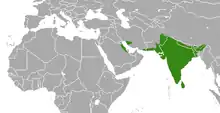 |
 |
Javan mongoose (H. javanicus) (Geoffroy Saint-Hilaire, 1818)[14] | LC[16] |
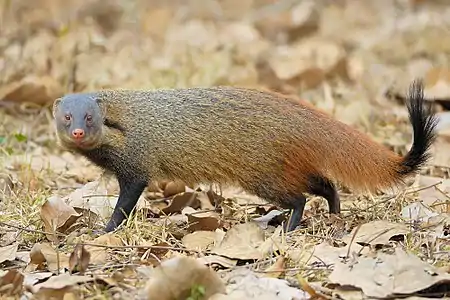 |
Stripe-necked mongoose (H. vitticollis) Bennett, 1835[17] | LC[18]
|
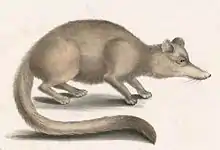 |
Crab-eating mongoose (H. urva) (Hodgson, 1836)[19] | LC[20]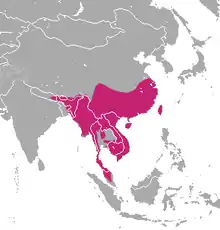 |
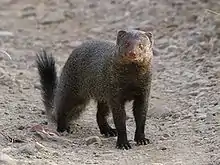 |
Ruddy mongoose (H. smithii) Gray, 1837[21] | LC[22]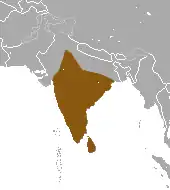 |
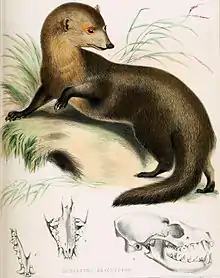 |
Short-tailed mongoose (H. brachyurus) Gray, 1837[21] | NT[23]
|
 | Indian brown mongoose (H. fuscus) Waterhouse, 1838[24] | LC[25]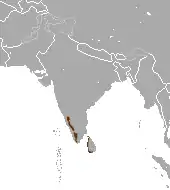 |
 |
Collared mongoose (H. semitorquatus) Gray, 1846[26] | NT[27] |
| Long-nosed mongoose (H. naso) de Winton, 1901[28] | LC[29]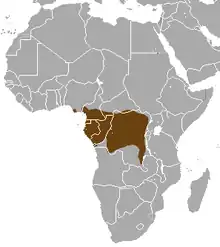 | |
References
- Wilson, D.E.; Reeder, D.M., eds. (2005). "Genus Herpestes". Mammal Species of the World: A Taxonomic and Geographic Reference (3rd ed.). Johns Hopkins University Press. ISBN 978-0-8018-8221-0. OCLC 62265494.
- Pomel, A. (1853). "Herpestes. Illig.". Catalogue méthodique et descriptif des vertébrés fossiles découverts dans le bassin hydrographique de la Loire. Paris: Baillière. pp. 64–66.
- Fredga, K. (1977). "Chromosomal Changes in Vertebrate Evolution". Proceedings of the Royal Society of London. Series B, Biological Sciences. 199 (1136): 377–397. JSTOR 77302.
- Taylor, M.E. & Matheson, J. (1999). "A craniometric comparison of the African and Asian mongooses in the genus Herpestes (Carnivora: Herpestidae)". Mammalia. 63 (4): 449–464. doi:10.1515/mamm.1999.63.4.449.
- Veron, G.; Colyn, M.; Dunham, A. E.; Taylor, P. & Gaubert, P. (2004). "Molecular systematics and origin of sociality in mongooses (Herpestidae, Carnivora)". Molecular Phylogenetics and Evolution (30): 582–598. doi:10.1016/S1055-7903(03)00229-X.
- Illiger, C. (1815). "Überblick der Säugethiere nach ihrer Verteilung über die Welttheile" [Overview of mammals according to their distribution across the World]. Abhandlungen der physikalischen Klasse der Königlich-Preußischen Akademie der Wissenschaften. 1804−1811: 39−159.
- Rüppell, E. (1835). "Herpestes. Illiger". Neue Wirbelthiere zu der Fauna von Abyssinien gehörig [New vertebrates belonging to the Fauna of Abyssinia] (in German). Frankfurt am Main: S. Schmerber. pp. 27–32.
- Gray, J.E. (1864). "A revision of the genera and species of Viverrine animals (Viverridae) founded on the collection in the British Museum". Proceedings of the Zoological Society of London (November): 502–579.
- Thomas, O. (1882). "On the African Mungooses". Proceedings of the Zoological Society of London (January): 59–93.
- Mivart, St. G. J. (1882). "On the Classification and Distribution of the Aeluroidea". Proceedings of the Zoological Society of London (February): 135–270.
- Lydekker, R. (1887). "Herpestes lemanensis, Pomel". Catalogue of the fossil Mammalia in the British museum, (Natural History). 5, Supplement. London: British Museum (Natural History). p. 317.
- Linnaeus, C. (1758). "Viverra ichneumon". Caroli Linnæi Systema naturæ per regna tria naturæ, secundum classes, ordines, genera, species, cum characteribus, differentiis, synonymis, locis. Tomus I (decima, reformata ed.). Holmiae: Laurentius Salvius. p. 41. (in Latin)
- Do Linh San, E.; Maddock, A.H.; Gaubert, P. & Palomares, F. (2016). "Herpestes ichneumon". IUCN Red List of Threatened Species. 2016: e.T41613A45207211.
- Geoffroy Saint-Hilaire, É. (1817). "De l'Ichneumon. Ichneumon pharaon". In Jomard, E. F. (ed.). Description de l'Égypte, ou, Recueil des observations et des recherches qui ont été faites en Égypte pendant l'éxpédition de l'armée française. Tome II. Paris: Commission des Sciences et Arts d'Egypte. pp. 137–144.
- Mudappa, D. & Choudhury, A. (2016). "Herpestes edwardsii". IUCN Red List of Threatened Species. 2016: e.T41611A45206787.
- Chutipong, W.; Duckworth, J. W.; Timmins, R.; Willcox, D. H. A. & Ario, A. (2016). "Herpestes javanicus". IUCN Red List of Threatened Species. 2016: e.T70203940A45207619.
- Bennett, E. T. (1835). "Remarks on some Mammalia from Travancore, including a New Species of Herpestes". Proceedings of the Zoological Society of London. III: 66–67.
- Muddapa, D.; Choudhury, A. & Punjabi, G. A. (2016). "Herpestes vitticollis". IUCN Red List of Threatened Species. 2016: e.T41619A45208503.
- Hodgson, B. H. (1836). "Synoptical description of sundry new animals, enumerated in the Catalogue of Nepalese Mammals". Journal of the Asiatic Society of Bengal. 5: 231–238.
- Choudhury, A.; Timmins, R.; Chutipong, W.; Duckworth, J. W.; Mudappa, D. & Willcox, D. H. A. (2015). "Herpestes urva". IUCN Red List of Threatened Species. 2015: e.T41618A86159618.
- Gray, J. E. (1837). "Description of some or little known Mammalia, principally in the British Museum Collection". The Magazine of Natural History and Journal of Zoology, Botany, Mineralogy, Geology and Meteorology. I (November): 577–587.
- Mudappa, D. & Choudhury, A. (2016). "Herpestes smithii". IUCN Red List of Threatened Species. 2016: e.T41617A45208195.
- Duckworth, J. W.; Mathai, J.; Ross, J. & Wilting, A. (2016). "Herpestes brachyurus". IUCN Red List of Threatened Species. 2016: e.T41610A45206655.
- Waterhouse, G.R. (1838). "On two new species of Mammalia, from the Society's collection, belonging to the genera Gerbillus and Herpestes". Proceedings of the Zoological Society of London. VI: 55–56.
- Mudappa, D.; Jathanna, D. (2015). "Herpestes fuscus". IUCN Red List of Threatened Species. 2015: e.T41612A45207051.
- Gray, J.E. (1846). "New species of Mammalia". The Annals and Magazine of Natural History; Zoology, Botany, and Geology. 18 (118): 211–212.
- Mathai, J.; Hearn, A.; Brodie, J.; Wilting, A.; Duckworth, J. W.; Ross, J.; Holden, J.; Gemita, E. & Hon, J. (2015). "Herpestes semitorquatus". IUCN Red List of Threatened Species. 2015: e.T41616A45208027.
- de Winton, W. E. (1901). "Description of a New Mongoose from West Africa". Bulletin of the Liverpool Museums under the City Council. 3 (2): 35–37.
- Ray, J.; Bahaa-el-din, L.; Angelici, F. M. & Do Linh San, E. (2015). "Herpestes naso". IUCN Red List of Threatened Species. 2015: e.T41615A45207915.

